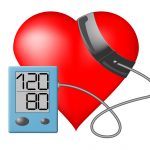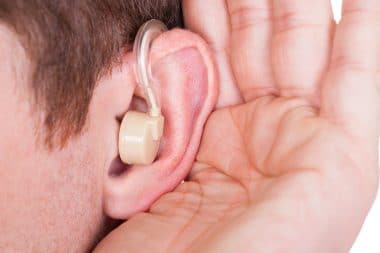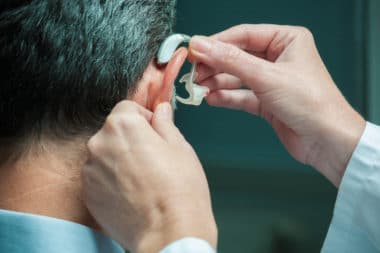Hearing loss due to aging is one of the most common conditions in the United States. Around 25% of the US population between the ages of 55 and 64 suffers some degree of hearing loss. If you are older than 65, your chance of having hearing problems shoots up (maybe say “increases”) to almost 1 in 2.
While aging is a very common factor that contributes to hearing loss, excessive earwax and exposure to loud sounds can also be factors.
Most types of hearing loss are permanent and irreversible. The good news is that over 95% of hearing loss cases are treatable with the use of a hearing aid. You should consult with a hearing health specialist to make the most of the hearing that you still have.
Signs and Symptoms of Hearing Loss
The signs and symptoms of hearing loss include:
– Muffling of the sounds that you hear
– Difficulty understanding what people are saying, especially against background noise or in a crowd of people
– Difficulty hearing consonants
– Asking other people to speak more clearly
– Turning up the volume on the television
– Withdrawal from conversation
– Avoidance of social interaction
How People Hear
You hear sounds when sound waves reach the structures inside your ear. The sound wave vibrations are converted to nerve signals that your brain recognizes as sound.
Your ear is composed of three areas. These are the outer ear, the middle ear, and the inner ear. Sound waves travel through the outer ear and make the eardrum vibrate. The eardrum and the three small bones of the middle ear amplify the vibrations when they come to the inner ear. Then, the vibrations travel through fluid in a structure called the cochlea.
The cochlea contains many tiny hairs that convert the vibrations into electrical impulses that then travel to your brain.
Hearing Loss Causes
The causes of hearing loss include:
– Damage to the inner ear
Aging and exposure to loud sounds can cause degeneration of the hairs or nerve cells in the cochlea. When these are damaged or missing, it interferes with the transmission of the signals to the brain.  You might have trouble hearing higher pitched sounds. This kind of hearing loss is permanent. Viral infections, such as mumps, measles, or meningitis can cause sensorineural hearing loss. Damage to your inner ear can also be caused by a blow to the head or exposure to an extremely loud sounds, such as an explosion or loud concerts.
– Too much earwax
Earwax may block the ear canal and interfere with the conduction of sound waves.
This issue can be simply addressed with the removal of the wax.
– Ear infections and abnormal bone growths or tumors
These can occur in the outer or middle ear.
– Ruptured eardrum
Loud noises and rapid changes in pressure can cause a rupture in your eardrum. You may also end up with a ruptured eardrum if you poke your eardrum or have an infection.
Treatments
When you have problems hearing, there is help available. The different options for treatment include the following:
– Ear wax removal
If you have a problem with earwax buildup, then this can be easily resolved by removing it. Your doctor can do this by loosening it with oil and then flushing it out. There are also over-the-counter solutions available to remove earwax build-up.
– Hearing aids
For most types of hearing loss, remedy is possible with a hearing device that amplifies sounds to compensate for middle or inner ear damages.
– Surgery
Surgery can help if you have sustained a traumatic ear injury or have had an infection that requires the insertion of drainage tubes. Surgery may also be required to repair eardrum ruptures or damage to a middle ear structure due to chronic ear infection.
– Cochlear implants
People who have profound hearing loss may wish to pursue a cochlear implant. These implants convert sounds outside your ear and deliver electrical impulses to your inner ear through tiny electrode implant.
Hearing Aids
If you have typical hearing loss in the range of mild to severe, , then a hearing aid can be the possible resolution to your hearing problem. The truth is that only about one out of five people who can benefit from a hearing aid actually use one. You shouldn’t allow embarrassment to interfere with getting help.
What Is a Hearing Aid?
A hearing aid is a miniature electronic device that you can place in or behind your ear. It selectively amplifies sounds so that you can hear and communicate more easily.
A hearing aid consists of three basic components. These are the microphone, the sound processor, and the speaker. The sound waves enter the microphone, and it converts them to electrical signals. These signals then come to the sound processor which amplifies the electrical signal according to the hearing loss pattern and deliver amplified sounds to the ear via a miniature speaker.
How Can a Hearing Aid Help?
Hearing aids are recommended for most types of hearing loss, including sensorineural loss that results from damage to the hair cells in the inner ear. The hearing aid amplifies the sound vibrations according to individual hearing loss patterns. The surviving hair cells receive those amplified signals. If hearing loss is in the range of mild to severe, it can be effectively treated with a modern hearing aid that selectively amplifies sounds only at the frequencies of hearing loss.
Determining that You Need a Hearing Aid
If you are having problems with your hearing, then you should consult with your primary physician. Your doctor can then refer you to an otolaryngologist or an audiologist.
The Different Styles of Hearing Aids
– Behind-the-ear hearing aids
This type of hearing aid consists of a hard plastic case that is placed behind the ear and connected to a an ear piece that goes into the outer ear. The electronic components are contained in the part that goes behind the ear.
A new type of behind-the-ear device is called a Receiver-In-Canal (RIC). It goes mostly behind the ear, with the speaker fitting into the ear canal. RIC type can also have an open-fit, meaning the earpiece is vented inside the ear which allows for a more natural hearing experience for the mild and moderate type of hearing loss. Â For most other types of hearing loss, closed-fit is required to provide higher level of amplifications without worrying about feedback (whistling)
– In-the-ear hearing aids
This type of hearing aid fits partially or completely inside the outer ear depending on the style.
– Canal hearing aids
Canal hearing aids fit into the ear canal. A completely-in-canal hearing aid is designed to be completely hidden in the canal. Since they are small, canal aids might be difficult to handle for those with limited dexterity.
Read this article if you have problems hearing and want to know what to do about it. Nowadays, you have real options! #HealthStatus
Key Points
- 1You should not be embarrassed to confront a hearing loss issue. If you do not address it, it can greatly affect your ability to socially interact.
- 2A hearing aid is useful only if you still have some hearing left. It will not help a person with profound hearing loss and those who cannot hear improved amplification from hearing aids.
- 3Purchasing a hearing aid should not be a complicated affair. You can conduct research online for best prices and options available, and should consult with a hearing professional if you suspect a medical condition such as sudden hearing loss, pain in the ear, or single-sided hearing loss that has not been previously diagnosed.
Digital Hearing Aids
Most hearing aids sold today are digital type – which means they rely on digital sound processing technology to covert sound waves into numerical codes and then digitally manipulate before converting back to amplified sound waves. The fact that it is “digital” makes it easier to process and alter the sound waves to suit the needs of the wearer.
There is a wide range of prices for hearing aids. Just because a device is more expensive does not mean that it would better suit your needs.
Which Hearing Aid Should You Choose?
The hearing aid that is right for you depends on the type and severity of your hearing loss. If you have issues in both of your ears, then you will probably need a binaural set- a hearing aid in each ear. Binaural hearing is advantageous to perceive sounds in a balanced way – which improves your hearing ability in challenging situations such as a noisy restaurant setting.
There is a wide range of prices for hearing aids. Just because a device is more expensive does not mean that it would better suit your needs. Do your research online for best features and prices, or consult with a hearing professional.
New Types of Hearing Aids
-Implantable hearing aids
New implantable hearing aids are designed to help the transmission of sound vibrations entering the inner ear. A middle-ear implant is a small device that attaches to one of the bones of the middle ear. Instead of amplifying the sound, this type of device moves the bones themselves.
-Bone-anchored hearing aid
A bone-anchored hearing aid is a small device that connects to a bone behind the ear. This device transmits sound vibrations to the inner ear through the skull. Surgery is required to implant either of these types of devices.
-Self-programming hearing aids
Self-programming hearing aids that can be purchased online and programmed at home with remote professional support (telemedicine) is a new option that can save you time and money and works for the most common types of hearing loss that are not associated with a medical condition.
Financial Assistance for Hearing Aids
Although most health insurance plans do not cover hearing aids, some do. Medicaid will pay some of the costs involved for children and young adults.
Medicare does not cover the cost of hearing aids for adults. There are some nonprofit organizations that provide financial assistance for hearing aids. You should contact the National Institute on Deafness and Other Communication Disorders Information Clearinghouse.








Reply